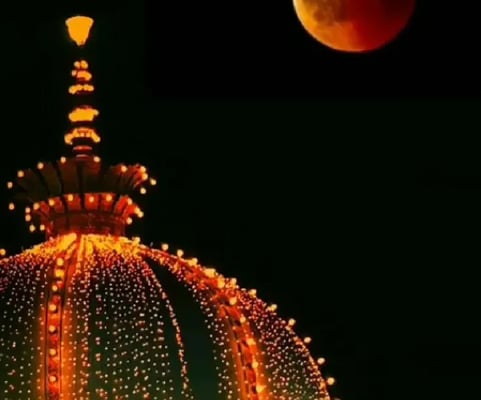This website is available in Hindi or English language
Ajmer Sharif Dargah, Rajasthan Another of the important pilgrimage sites in India is located at the heart of Ajmer. The tomb provides for the convergence of not just lakhs of devotees from both religious sides, but also a unique and proud mix-match space which is generally enveloped by spirituality though occasionally history meets culture inside. The dargah is more than a place of pilgrimage; it encapsulates the inclusive and mystical ethos that defines Sufism. Historical BackgroundKhwaja Moinuddin Chishti (Known as Gareeb Nawaz) was a 12th century Saint who also introduced Islam in Indian continent. He traveled across the Middle East because of being from Persia and then permanently lived in Ajmer, where he spent his life towards serving poor people for fanning a bond of spiritual love among each other. His message was rooted in social equality, brotherhood and a personal relationship with God that cut across all class barriers. After his demise in 1236, he was followed by many people and they had the dargah built to him. The site was further developed under the Mughal emperors over time to create the grand complex that exists today — an example of Indo-Islamic architecture. Architectural Marvel Ajmer Sharif is a piece of architectural marvel with beautiful workmanship and the kind. The Nizam Gate is the entry to this artistry in stone enriched by elegant carvings and inscriptions, which ushers into an ambiance reminiscent of peace. You walk in, and the ambiance is different; it smells like incense and you can hear soft prayers that give a touch of peace. The silver-clad, marbled-inlaid central shrine at the [top] is a sight to behold. The actually grave of Khwaja Moinuddin Chishti is covered by a Green and Gold canopy indicating its status as a Divinely Sacred Sanctum (Sarcaophagus) — hayaatus Sarcar-e-Aqdas ). It is believed that offering of chadar (ceremonial cloth) and flowers by pilgrims at the tomb, fulfills their wishes. It also has a lovely courtyard to host thousands of devotees. Its beautiful architecture of arches and domes results in an enchanting atmosphere that adds spirituality to the surroundings. The marble work and calligraphy in the masjid are further evidence of arts period.
Spiritual Significance
What sets Ajmer Sharif Dargah apart from other religious sites is its universal charm. Individuals from diverse backgrounds, irrespective of their beliefs, visit the dargah seeking comfort, healing, and direction. The spirit of Sufism, which highlights love and devotion to God, turns the dargah into a sanctuary where people come together to pray and find tranquility.
Many devotees hold the belief that Khwaja Moinuddin Chishti can intercede for them, often sharing personal accounts of miraculous experiences following their visits to the dargah. The act of tying a thread on a tree within the complex, known as the Badi Dargah, represents a heartfelt plea for assistance and a promise to return once their wish is granted.
The Ajmer Sharif Dargah is not confined to mere religious rites; it has also become an active sociocultural hub. A hive of activity surrounds it and it has markets selling everything from art articles to sweetmeats. Local vendors come with Indian souvenirs, colourful and ornamental strings of prayers, and fabrics.
The dargah remains alive to many festivals and occasions throughout the year, each attracting thousands of people. The most notable of these is the holiday called Urs when devoted Muslims celebrate the death of their saint Khwaja Moinuddin Chishti. All such periods see the dargah decorated with flowers and all kinds of special prayers, and other activities held. There are various activities including Qawwali, a form of Sufi music which complements the dargah’s atmosphere.
Dargah of Ajmer Sharif offers an incredible opportunity to experience a great historical and spiritual past. The atmosphere as you near the dargah changes completely to one on reverence. Such places demand modesty and decorum from the visitors in the premises. Once you get inside, you may be welcomed in a sea of people who have come there with hopes and dreams like you.
While you are there, it would be beneficial to engage in some introspect and meditation. The view from the dargah is inviting and calm as you are able to centre one’s thoughts and feelings. It is indeed a joy to be where other pilgrims are present with their own shares of prayers and stories.
For those wishing to explore this particular monument and its meaning, the services of local guides who will tell you something interesting to make the visit even better are at their disposal. This knows-how further enhances the visit in the sense that the visitor is able understand and appreciate more the historical events that happen to be present in the site.
A Place of Healing
Many visitors flock to Ajmer Sharif Dargah in order to embrace healing, be it physically, emotionally, or spiritually. Many accounts tell of people who prayed at the tomb and found their sorrow and weakness replaced by hope and strength. Such a place does exist where people in distress come in to help out, it is the dargah, where they can speak about their fears, wishes and aspirations.
Also the dargah in its essence is very communal and thus fosters a feeling of togetherness.
Ajmer Sharif Dargah serves as the oasis of love, acceptance, and commitment despite the harsh realities of the world filled with discrimination’s. The Place is quite rich in History and offers magnificent architectural beauty along with deep religious overtones making it a compulsory stop for any person traveling to Rajasthan. The shrine irrespective of whether one visits for faith, history, or purely for the sake of beauty, is an experience that is very potent and one that stays with you even after you have left the premises.
Ajmer Sharif Dargah uplifts the probability theory through such a faith that categorization of human beings in poles apart structural principles is not possible, but rather there is oneness in the soul of every human being. Here, between worship and devotion, one feels the spirit of humanity best; full of love, hope and yearning for peace.


